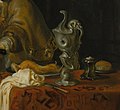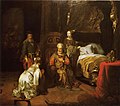
Gerbrand van den Eeckhout, was a Dutch Golden Age painter and a favourite student of Rembrandt. He was also an etcher, an amateur poet, a collector and an adviser on art.

Nicolaes Maes was a Dutch painter known for his genre scenes, portraits, religious compositions and the occasional still life. A pupil of Rembrandt in Amsterdam, he returned to work in his native city of Dordrecht for 20 years. In the latter part of his career he returned to Amsterdam where he became the leading portrait painter of his time. Maes contributed to the development of genre painting in the Netherlands and was the most prominent portrait painter working in Amsterdam in the final three decades of the 17th century.
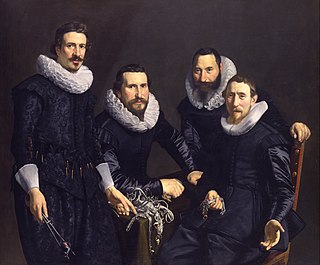
Thomas de Keyser was a Dutch portrait painter, a dealer in Belgium bluestone and stone mason. He was the most in-demand portrait painter in the Netherlands until the 1630s, when Rembrandt eclipsed him in popularity. Rembrandt was influenced by his work, and many of de Keyser's paintings were later falsely attributed to Rembrandt.

The Hague School is a group of artists who lived and worked in The Hague between 1860 and 1890. Their work was heavily influenced by the realist painters of the French Barbizon school. The painters of the Hague school generally made use of relatively somber colors, which is why the Hague School is sometimes called the Gray School.

Gabriël Metsu (1629–1667) was a Dutch painter of history paintings, still lifes, portraits, and genre works. He was "a highly eclectic artist, who did not adhere to a consistent style, technique, or one type of subject for long periods". Only 14 of his 133 works are dated.

Hendrick Jansz ter Brugghen was a Dutch painter of genre scenes and religious subjects. He was one of the Dutch followers of Caravaggio – the so-called Utrecht Caravaggisti. Along with Gerrit van Hondhorst and Dirck van Baburen, Ter Brugghen was one of the most important Dutch painters to have been influenced by Caravaggio.
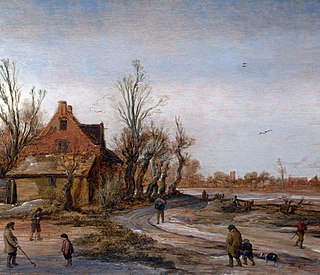
Esaias van de Velde was a Dutch landscape painter.

Jan Lievens was a Dutch Golden Age painter who was associated with his close contemporary Rembrandt, a year older, in the early parts of their careers. They shared a birthplace in Leiden, training with Pieter Lastman in Amsterdam, where they shared a studio for about five years until 1631. Like Rembrandt he painted both portraits and history paintings, but unlike him Lievens' career took him away from Amsterdam to London, Antwerp, The Hague and Berlin.

Jan Jacobszoon Hinlopen was a rich Dutch cloth merchant, an officer in the civic guard, a real estate developer in the Jordaan, alderman in the city council and a keen art collector. He would have been elected as a burgomaster, if he had not died at the age of forty, an age considered acceptable to be eligible. He was a prominent patron of the arts in his time, and there is some speculation on being an influential protector of Rembrandt and it is likely that he had good connections with Gabriel Metsu. Hinlopen, like his father-in-law, Joan Huydecoper I, is known in art history because of the poems by Jan Vos reciting the paintings in his house and members of the family. These paintings are spread all over the world, the poems nearly forgotten.
Gerrit van Uylenburgh, or Gerrit Uylenburgh, was a Dutch Golden Age painter and art-dealer. He was the eldest son of Hendrick van Uylenburgh and took over the family art-dealing business after Hendrick's death and burial in the Westerkerk church in 1661. This business, then in a house on Lauriergracht, formerly owned by Govaert Flinck, played a key role in the art world of the Dutch Golden Age.
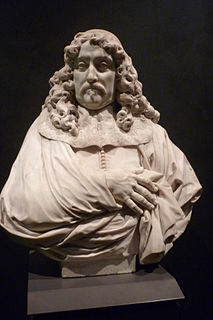
Free Imperial Knight Andries de Graeff was a very powerful member of the Amsterdam branch of the De Graeff - family during the Dutch Golden Age. He became a mayor of Amsterdam and a powerful Amsterdam regent after the death of his older brother Cornelis de Graeff. Like him and their father Jacob Dircksz de Graeff he opposed the house of Orange. In the mid-17th century he controlled the finances and politics.

The Continence of Scipio, or The Clemency of Scipio, is an episode recounted by Livy of the Roman general Scipio Africanus during his campaign in Spain during the Second Punic War. He refused a generous ransom for a young female prisoner, returning her to her fiancé Allucius, who in return became a supporter of Rome. In recognition of his magnanimous treatment of a prisoner, he was taken as one of the prime examples of mercy during warfare in classical times. Interest in the story revived in the Renaissance and the episode figured widely thereafter in both the literary and visual arts, as well as opera.
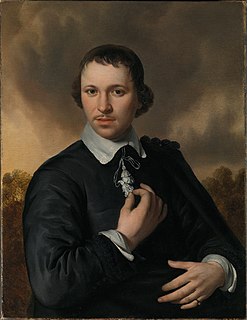
Jan van de Cappelle was a Dutch Golden Age painter of seascapes and winter landscapes, also notable as an industrialist and art collector. He is "now considered the outstanding marine painter of 17th century Holland". He lived all his life in Amsterdam, and as well as working as an artist spent much, or most, of his time helping to manage his father Franchoy's large dyeworks, which specialized in the expensive dye carmine, and which he eventually inherited in 1674. Presumably because of this dual career, there are fewer than 150 surviving paintings, a relatively small number for the industrious painters of the Dutch Golden Age. His marine paintings usually show estuary or river scenes rather than the open sea, and the water is always very calm, allowing it to act as a mirror reflecting the cloud formations above; this effect was Cappelle's speciality.

Daniël Vosmaer, was a Dutch Golden Age painter.

The auricular style or lobate style is a style of ornamental decoration, mainly found in Northern Europe in the first half of the 17th century, bridging Northern Mannerism and the Baroque. The style was especially important and effective in silversmithing, but was also used in minor architectural ornamentation such as door and window reveals, picture frames, and a wide variety of the decorative arts. It uses softly flowing abstract shapes in relief, sometimes asymmetrical, whose resemblance to the side view of the human ear gives it its name, or at least its "undulating, slithery and boneless forms occasionally carry a suggestion of the inside of an ear or a conch shell". It is often associated with stylized marine animal forms, or ambiguous masks and shapes that might be such, which seem to emerge from the rippling, fluid background, as if the silver remained in its molten state.

Adam van Vianen was a leading silversmith of the early Dutch Golden Age, who trained as an engraver and was also a medallist. Unlike his brother Paul van Vianen, he spent little time away from his native Utrecht. Together they developed the auricular style which bridges the gap between Northern Mannerist and Baroque ornament.

Pieter Stevensz. van Gunst, also known as Pieter Stevens van Gunst or Petrus Stephani, was a Dutch draughtsman, copperplate engraver and printmaker active in Amsterdam, London (1704), and the Dutch town of Nederhorst (1730-1731).

TheMemorial Guild Cupby Adam van Vianen is a 1614 silver-gilt covered ewer in the Rijksmuseum, commissioned by the Amsterdam goldsmiths' guild to commemorate the death of Adam's brother Paulus van Vianen. It is an iconic symbol of the auricular style developed by the two brothers.

The Continence of Scipio is a circa 1653 painting by Dutch artist Gerbrand van den Eeckhout. It shows the continence of Scipio and is now in the collection of the Rijksmuseum in Amsterdam.

The Adoration of the Magi, is a circa 1645 oil on panel painting of the Nativity by the Dutch artist Salomon Koninck in the collection of the Mauritshuis in The Hague.



